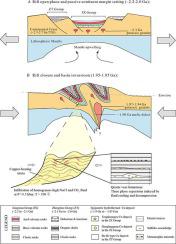Ore Geology Reviews ( IF 3.3 ) Pub Date : 2021-09-11 , DOI: 10.1016/j.oregeorev.2021.104462 Zheng-Jie Qiu 1, 2 , Hong-Rui Fan 1, 2, 3 , M. Santosh 4, 5 , Kui-Feng Yang 1, 2, 3 , Xiao-Chun Li 1, 2, 3 , Ting-Guang Lan 3, 6 , Yan-Wen Tang 6 , Yong-Xin Pan 2, 3

|
Epigenetic hydrothermal Cu-(Co) deposits are widely distributed in the Zhongtiao Mountains within the Paleoproterozoic Trans-North China Orogen in the North China Craton. Here we investigate the Henglingguan Cu deposit hosted in metasediments to gain insights on the fluid evolution characteristics associated with the ore formation. This Cu deposit is characterized by early disseminated mineralization and late quartz-vein type mineralization. The negative sulfur isotope values (about −10‰) of the vein sulfides suggests a sedimentary rock source for sulfur associated with the hydrothermal Cu mineralization. The coexistence of CO2-rich carbonic inclusions and halite-bearing inclusions within a single fluid inclusion assemblage suggests fluid immiscibility in the H2O-NaCl-CO2 system. Based on the fluid phase analysis, our data show that the parent ore fluid was characterized by X(NaCl) of 10 to 20 mol.% (salinity of around 23 to 41 wt% NaCl) and X(CO2) of 10 to 15 mol.% before fluid immiscibility. The estimated temperature–pressure conditions of 320 to 340 °C and 3.5 to 4.0 kbar based on the carbonic fluid inclusions is suggested to be close to the conditions of fluid immiscibility. In-situ composition analyses of fluid inclusions by LA-ICP-MS show that the ore fluids contained Na, Ca, Fe and Mn, and evolved towards Sr-Ba enrichment. The data are consistent with a metamorphic brine derived from the sedimentary rocks. The brine-rich metamorphic fluids were likely derived from the dehydration and decarbonation of evaporitic carbonate rocks developed on the basin margin or a passive continental margin. The decompression during post-collisional exhumation triggered fluid immiscibility resulting in the quartz vein-type Cu mineralization.
中文翻译:

盐分流体驱动前寒武纪变沉积物中的铜矿化:来自横贯华北造山带的证据
后生热液铜(钴)矿床广泛分布于华北克拉通古元古代横贯华北造山带内的中条山脉。在这里,我们调查了位于变质沉积物中的横岭关铜矿床,以深入了解与成矿相关的流体演化特征。该铜矿床以早浸染成矿和晚石英脉型成矿为特征。脉状硫化物的负硫同位素值(约 -10‰)表明与热液铜矿化相关的硫的沉积岩来源。单个流体包裹体组合中富含CO 2 的碳包裹体和含岩盐包裹体的共存表明 H 2 O-NaCl-CO 2中的流体不混溶系统。根据液相分析,我们的数据显示母矿流体的特征是 X(NaCl) 为 10 至 20 mol.%(盐度约为 23 至 41 wt% NaCl)和 X(CO 2 ) 为 10 至 15流体不混溶前的 mol.%。建议基于含碳流体包裹体估计的 320 至 340 °C 和 3.5 至 4.0 kbar 的温度-压力条件接近流体不混溶条件。原位LA-ICP-MS对流体包裹体的成分分析表明,矿液中含有Na、Ca、Fe和Mn,并向Sr-Ba富集方向演化。数据与源自沉积岩的变质卤水一致。富卤变质流体可能来源于盆地边缘或被动大陆边缘发育的蒸发碳酸盐岩的脱水脱碳作用。碰撞后折返过程中的减压引发了流体不混溶,导致石英脉型铜矿化。



























 京公网安备 11010802027423号
京公网安备 11010802027423号